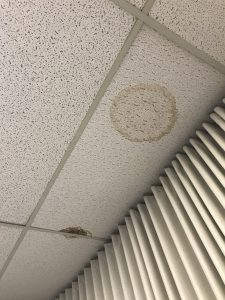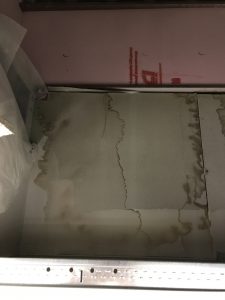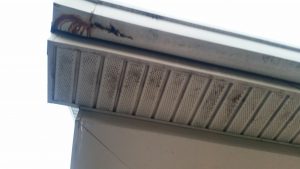We have an active renovation project under construction in Harrisonburg. It is a large facility that does not have a full-time maintenance crew working on the building leading to deferred maintenance. This particular building is a church which presents some unique challenges for maintaining the building systems.

Example of deferred maintenance:
The regular users of the building on a day-to-day basis typically only work in a small portion of the building. There are lots of people passing through the building once or twice a week, but not that have ownership of issues they might see. For instance, if there is a ceiling tile that has a water stain, someone who is only in the building on occasion will probably assume that someone in the building on a day-to-day basis is taking care of it. However, the day-to-day people may not know about the leak since they don’t regularly use the entire building. This leads to maintenance issues that go unchecked for longer than normal times.

When a problem is identified it needs to be corrected quickly. This leads to a service call that addresses the immediate issue, but probably does not look for the cause of the problem or address the long-term impacts.
Example deferred maintenance:
For instance, a strong rain comes from the north, which is unusual. The roof leaks in a new place that has not happened in the past. The roofer comes and adds caulk to the entry point on the roof to seal the roof from leaking again. This fixes the roof leak for the moment.
Questions not asked:
The questions that are not asked typically are why did that joint open up to allow the leak. Did the interior finish materials all get dried out adequately. Are there any interior materials that need to be replaced? Should the wall be opened up to investigate the moisture more fully?
I put both of these examples in the category of deferred maintenance. Nobody is to blame, it is just how things happen in large buildings that don’t have someone assigned specifically to maintenance. A building is the most complicated machine you will ever own. Weather conditions outside impact how the building performs. People using the building impact how the building performs. The way the building is constructed and the systems in the building impact how the building performs. There is not a standard answer to all the questions that will emerge. Buildings are complicated and there are a lot of moving parts. Deferred maintenance unfortunately will destroy the building. This is hard to avoid in a large facility that does not get regular daily use.

On this particular renovation project a team was assembled that could take on the challenge of correcting past deferred maintenance problems that were destroying the building. The team includes architect (Gaines Group Architects), contractor (Herr and Co.), Mechanical Engineer (Suter Engineering), Mechanical Contractor (Excel Heating and Cooling), Electrician (Copper Key), Drywallers (Schlabach Drywall), roofing contractor (Valley Roofing), flooring contractor (Weavers Flooring), and owners representative (Beck Builders). It takes a comprehensive team of experts to address all the issues. If you are facing any deferred maintenance concerns in your facility, give us a call and we can help you set a scope and select a team of experts to address the problems.




